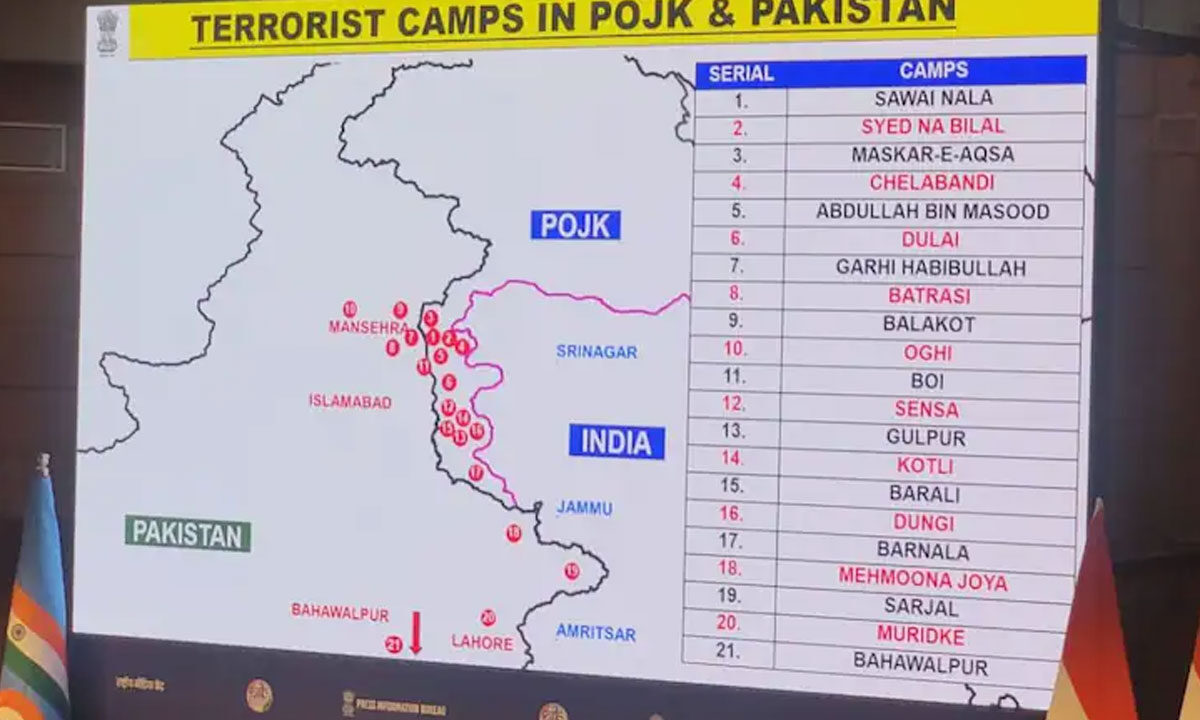Operation Sindoor: Army Releases Images of Terror Camps Targeted in Pakistan
The overnight operation, executed with advanced technology and strategic targeting, aimed to dismantle infrastructure used by terror outfits like Lashkar-e-Taiba and Jaish-e-Mohammad.

Colonel Sofiya Qureshi, Wing Commander Vyomika Singh, and Foreign Secretary Vikram Misri addressed the media on Wednesday following India’s precision strikes on nine terror camps located in Pakistan and Pakistan-Occupied Kashmir (PoK). The overnight operation, executed with advanced technology and strategic targeting, aimed to dismantle infrastructure used by terror outfits like Lashkar-e-Taiba and Jaish-e-Mohammad.
Table of Contents
Pakistan Targets: Lashkar and Jaish Strongholds Hit
Among the sites struck in Pakistan:
- Sarjal Camp, Sialkot: Located just 6 km from the International Border, it trained militants involved in the March attack that killed four policemen in J&K.
- Mehmoona Joya Camp, Sialkot: A Hizbul Mujahideen facility 12 km from the border; it coordinated the 2016 Pathankot airbase attack.
- Markaz Taiba, Muridke: Lashkar-e-Taiba’s headquarters, where 26/11 attacker Ajmal Kasab and David Headley reportedly received training.
- Markaz Subhanallah, Bahawalpur: Jaish-e-Mohammad’s main base for recruitment and indoctrination; frequented by its chief Masood Azhar.
PoK Strikes: Key Launchpads and Training Bases Neutralised
In Pakistan-Occupied Kashmir, India struck five high-value terror camps:
- Sawai Nala, Muzaffarabad: A LeT training facility linked to attacks in Gulmarg, Sonmarg, and Pahalgam.
- Syedna Bilal, Muzaffarabad: Used by Jaish-e-Mohammad for arms training and cross-border operations.
- Gulpur, Kotli: LeT’s base for infiltration into Rajouri-Poonch; linked to 2023 Poonch attacks and a bus attack on pilgrims.
- Abbas Camp, Kotli: Known for training suicide bombers; had a capacity of up to 50 recruits.
- Barnala Camp, Bhimber: Provided explosives and jungle warfare training; just 9 km from the LoC.
Strikes Carried Out with Precision, No Collateral Damage
Officials confirmed that the operations were executed using niche technology with warheads carefully chosen to limit impact only to the targeted terror infrastructure. “Each point of impact was a specific building or complex,” said Wing Commander Singh. “There were no hits on military facilities and no civilian casualties reported.”
Background: Response to Pahalgam Terror Attack
The air strikes, dubbed part of ‘Operation Sindoor’, were carried out in retaliation for the April 22 terrorist attack in Pahalgam, where 26 civilians, including a Nepali national, were killed. The Indian government held Pakistan-based terror groups responsible for the attack.
A Clear Message
“This is a message to those who think they can orchestrate terror from across the border,” said Colonel Qureshi. “The Indian armed forces will not hesitate to act decisively to protect our citizens.”
The Ministry of External Affairs reiterated that the operation was non-escalatory and aimed solely at eliminating terror networks.
